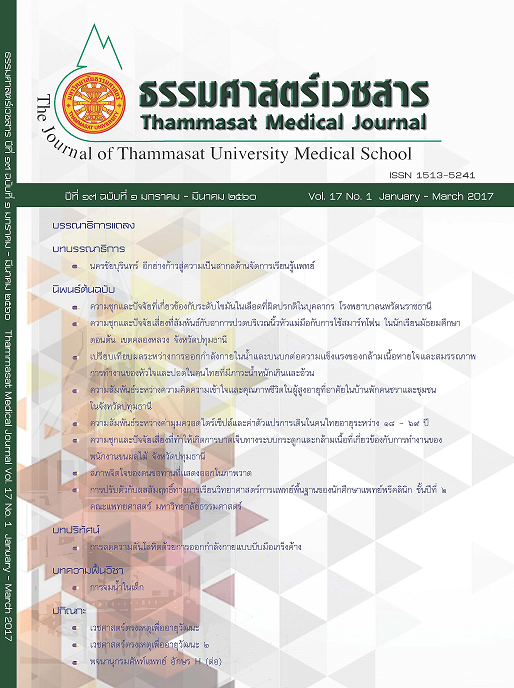Blood pressure reduction following isometric handgrip exercise
Keywords:
Hypertension, Isometric handgrip, Exercise, Resistance exercise, ความดันโลหิตสูง, การบีบมือแบบเกร็งค้าง, การออกกำลังกาย, การออกกำลังกายแบบมีแรงต้านAbstract
Hypertension is a major cause of death and leading to many complications. Lifestyle modification such as therapeutic exercise was recommended for high blood pressure management. The previous studies suggest that isometric handgrip exercise with an optimal prescription could be an effective strategy for reducing resting blood pressure. Despite the simplicity and less time consuming natures of this type of exercise, isometric handgrip exercise has been shown its efficacy to reduce blood pressure as aerobic exercise does. The possible underlying mechanisms that response for blood pressure reduction after isometric handgrip exercise are improved autonomic nervous system, improved vascular function, and reduced oxidative stress. Therefore, isometric handgrip exercise might be an alternative adjunct therapy for blood pressure reduction that need a short period of time for exercising. However this type of exercise is local exercise, it might not reduce another risk factors related to hypertension.
ความดันโลหิตสูงถือเป็นสาเหตุสำคัญของการเสียชีวิตรวมถึงภาวะแทรกซ้อนต่าง ๆ การปรับพฤติกรรมสุขภาพด้วยการออกกำลังกายจึงถูกแนะนำให้ใช้เพื่อจัดการภาวะความดันโลหิตสูง จากการทบทวนวรรณกรรมที่ผ่านมาชี้ให้เห็นว่าการออกกำลังกายด้วยการบีบมือแบบเกร็งค้างด้วยความหนักที่เหมาะสมสามารถลดความดันโลหิตในขณะพักได้ โดยเป็นที่น่าสนใจว่าการออกกำลังกายด้วยการบีบมือแบบเกร็งค้างเป็นการออกกำลังกายที่ง่าย ใช้เวลาสั้น แต่ยังสามารถให้ผลลดความดันโลหิตได้เช่นเดียวกับการออกกำลังกายแบบแอโรบิก โดยกลไกที่เกี่ยวข้องในการลดความดันโลหิตประกอบด้วยการปรับการทำงานของระบบประสาทอัตโนมัติ การปรับปรุงการทำงานของหลอดเลือด และการลดภาวะเครียดออกซิเดชั่น การออกกำลังกายแบบบีบมือเกร็งค้างจึงอาจเป็นอีกทางเลือกหนึ่งในการลดความดันโลหิต โดยมีจุดเด่นเรื่องการใช้เวลาที่สั้น อย่างไรก็ตามการออกกำลังกายรูปแบบดังกล่าวเป็นเพียงการออกกำลังกายเฉพาะที่ จึงอาจไม่ส่งผลในการลดปัจจัยเสี่ยงอื่น ๆ ที่เกี่ยวข้องกับการมีระดับความดันโลหิตสูง



